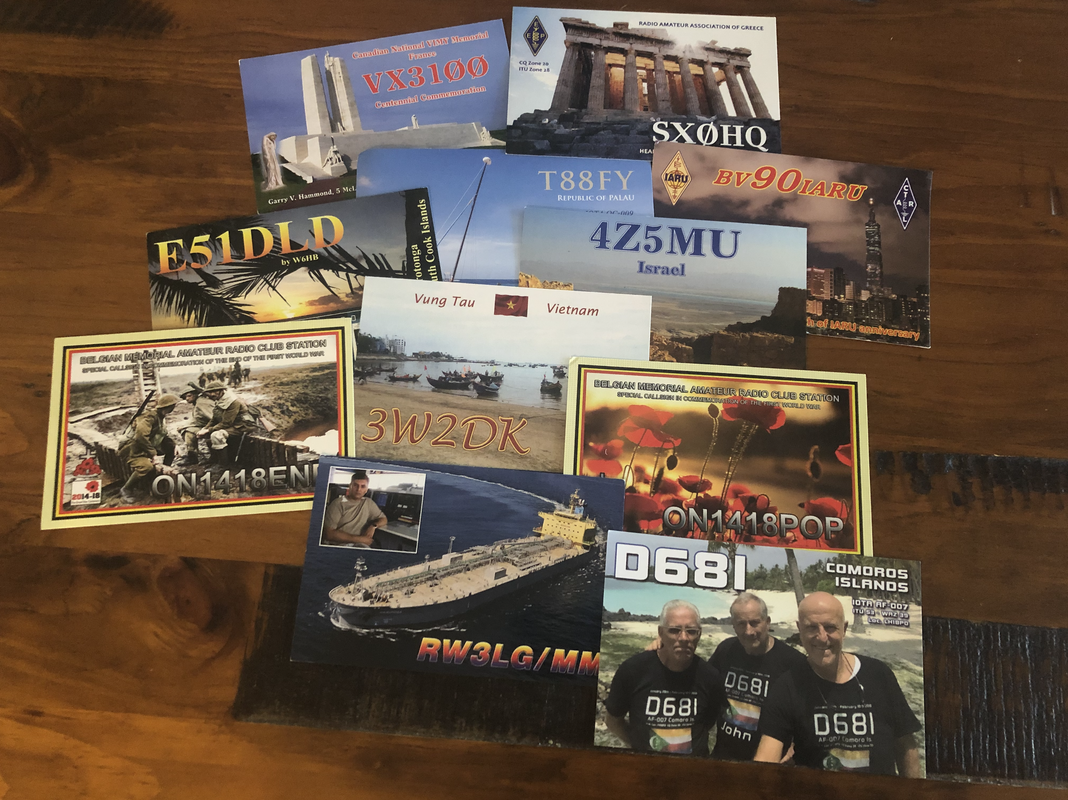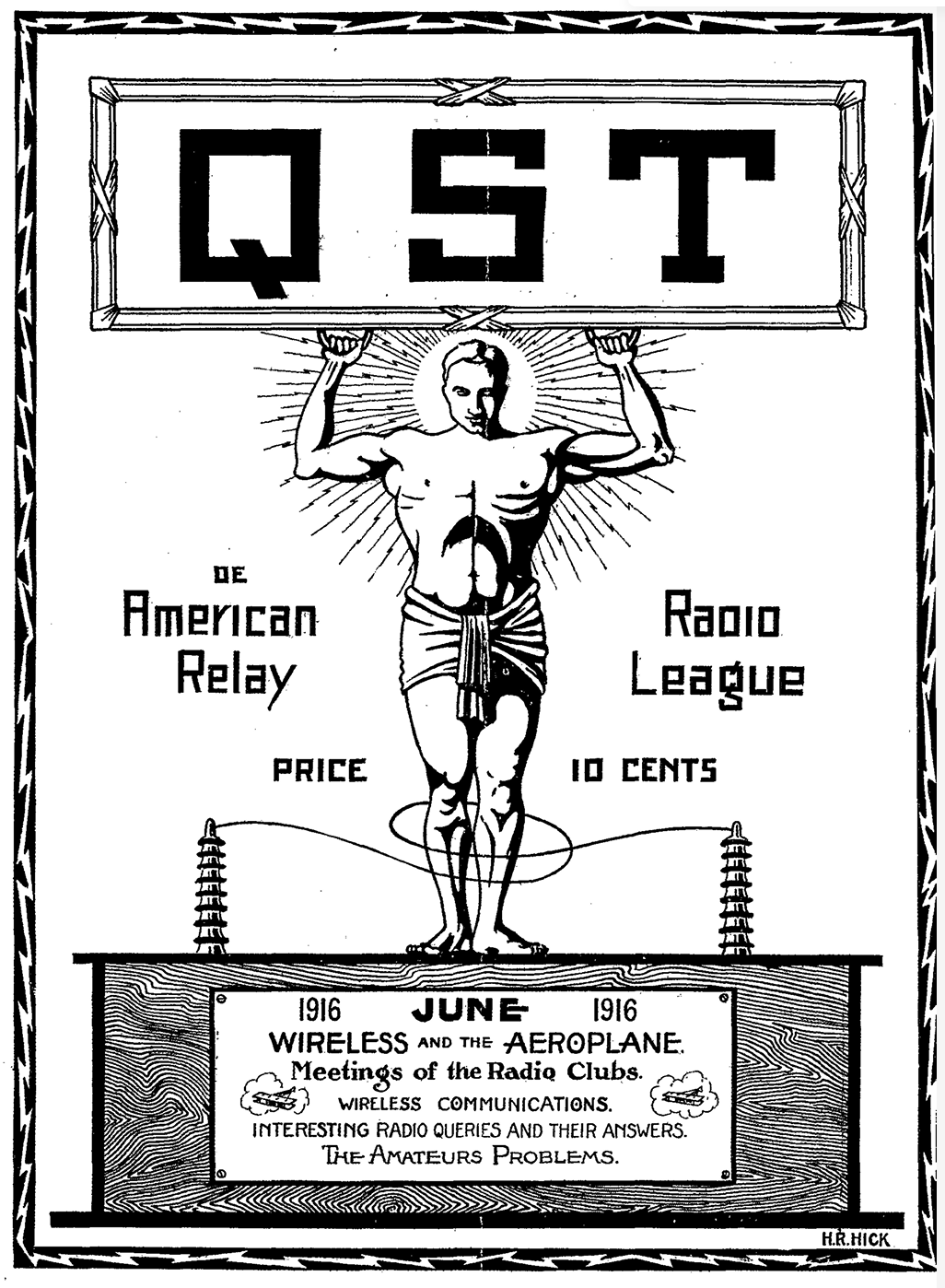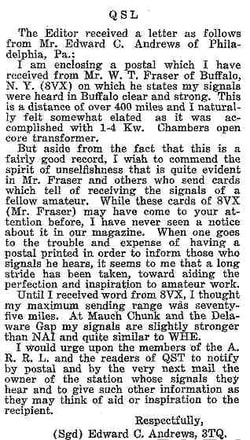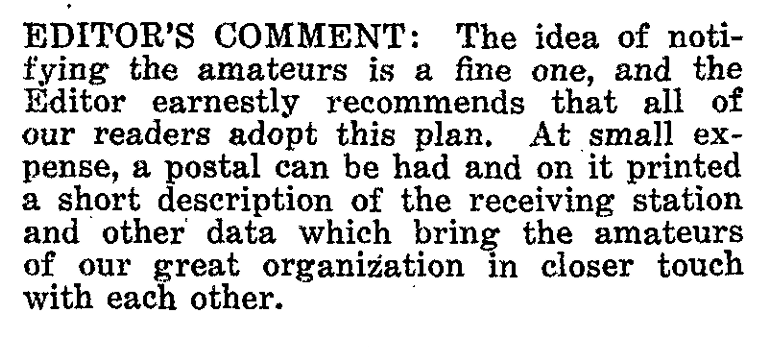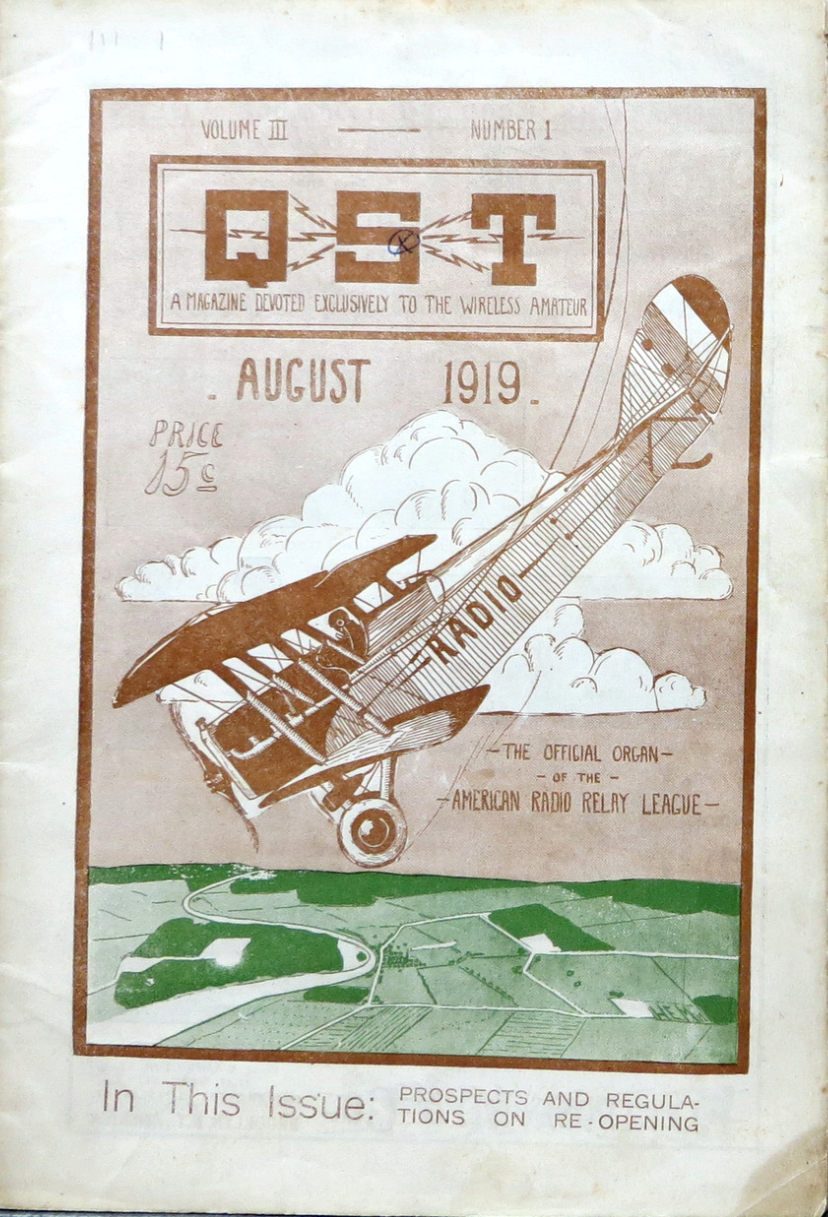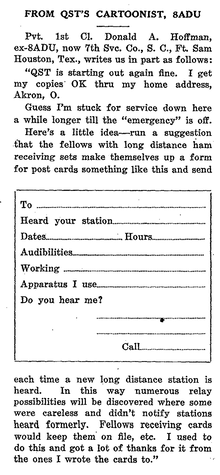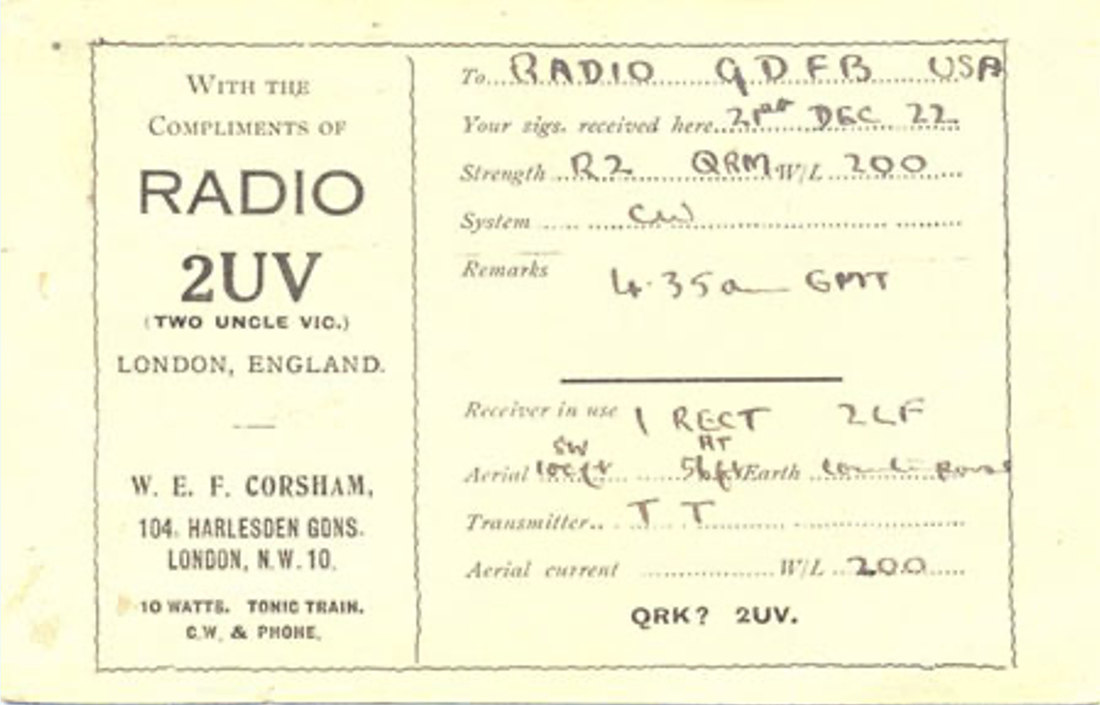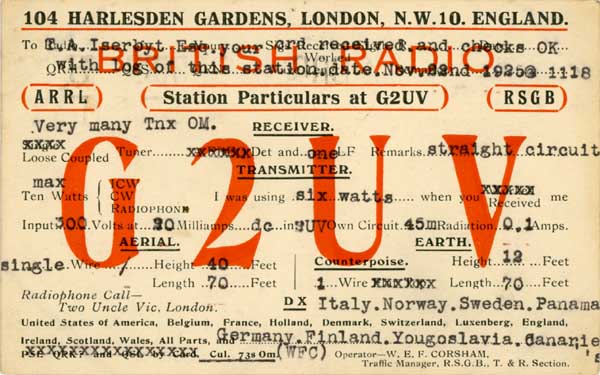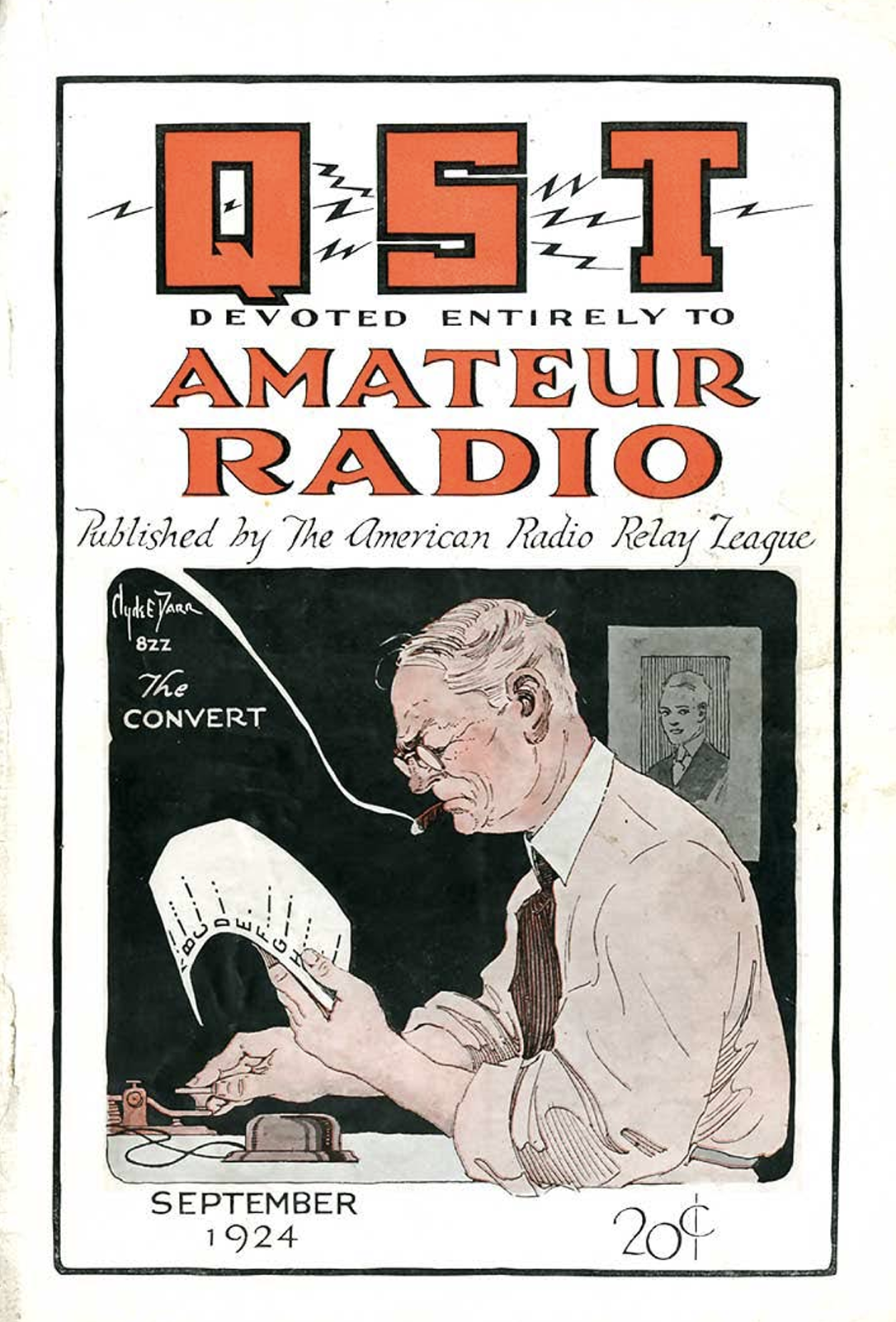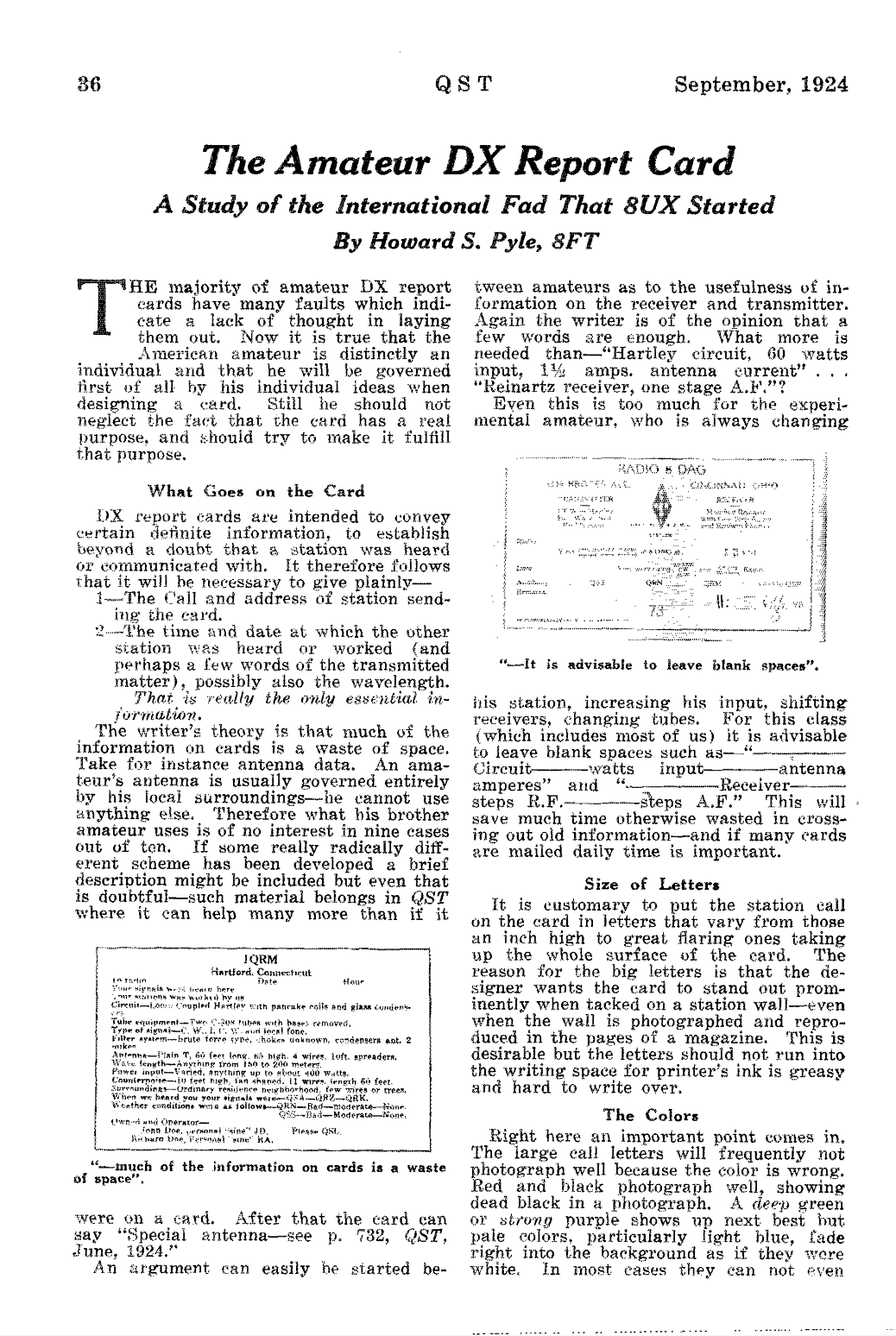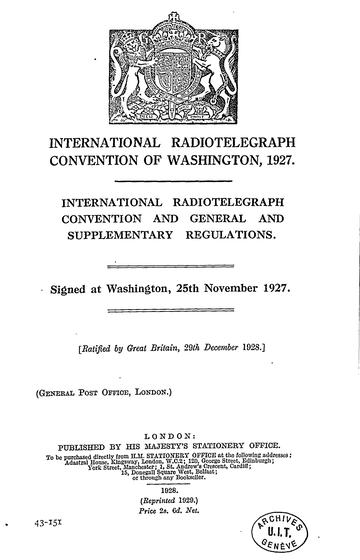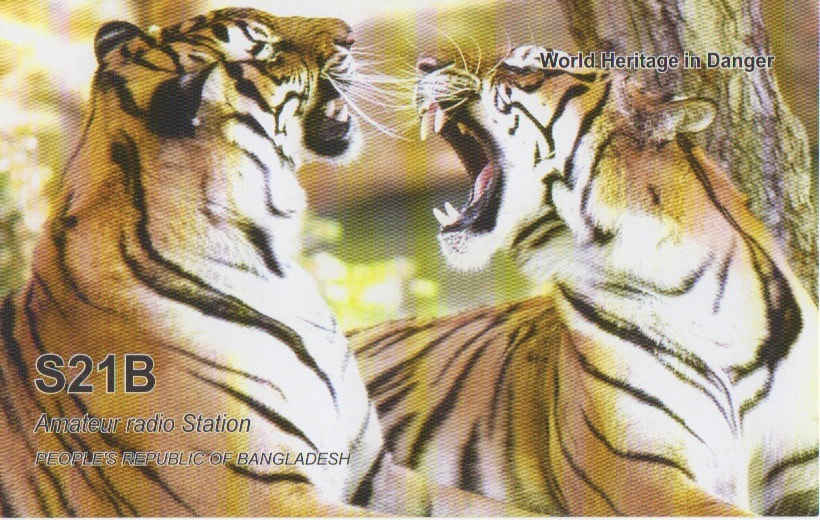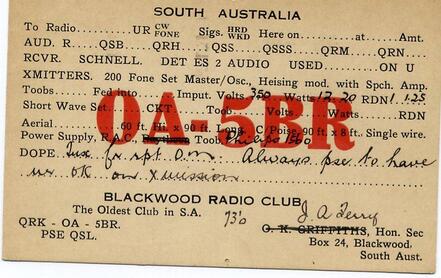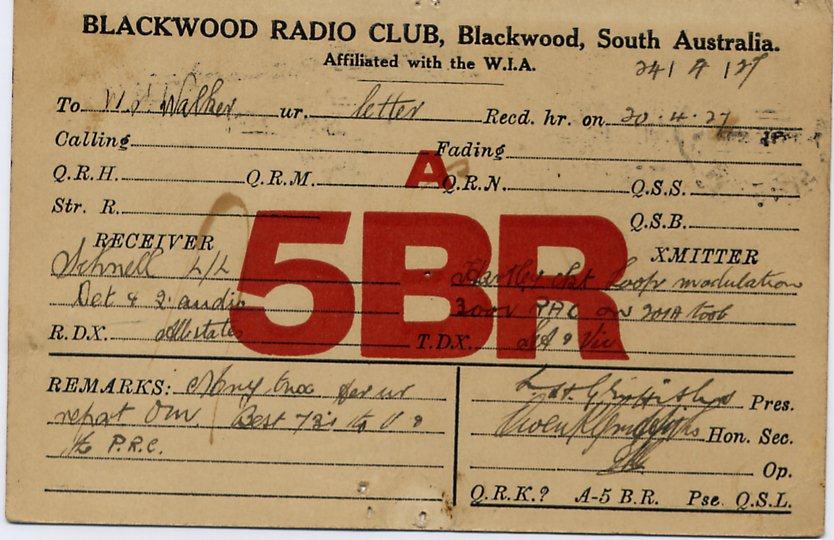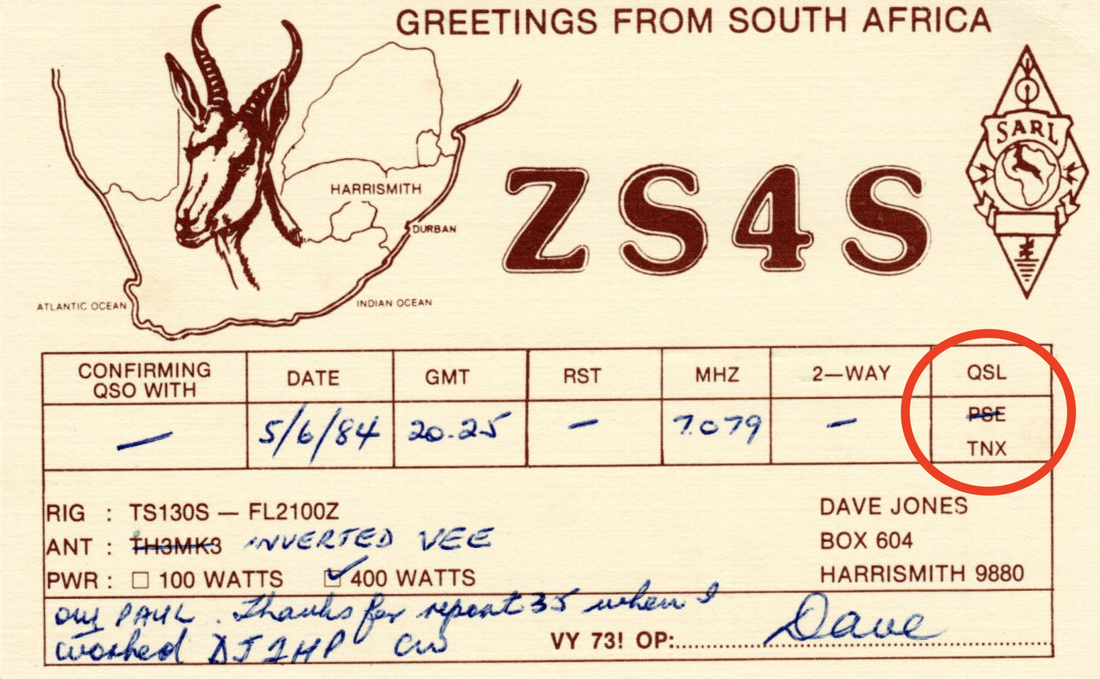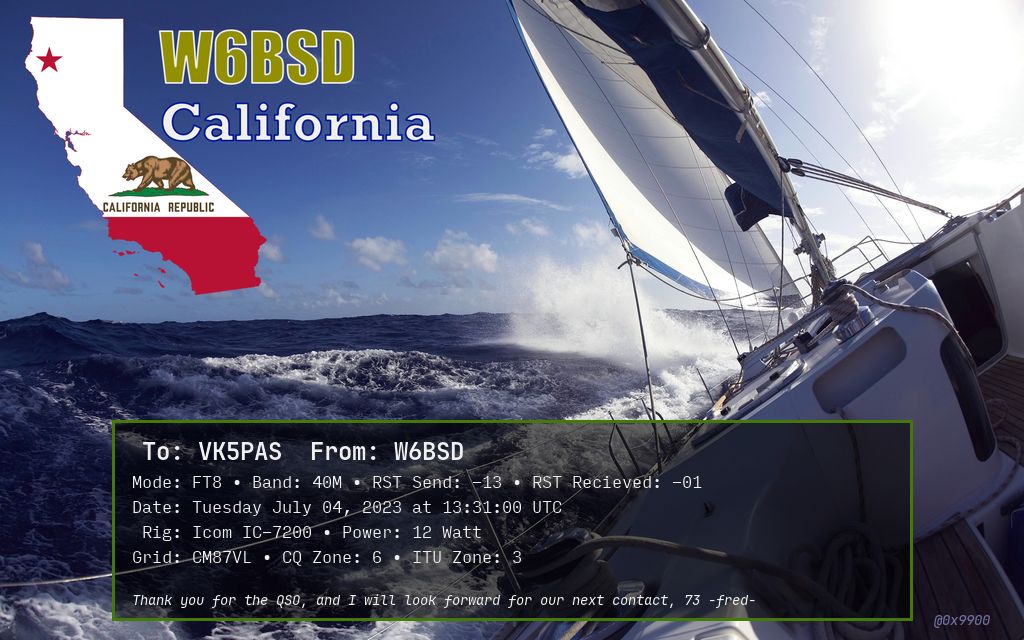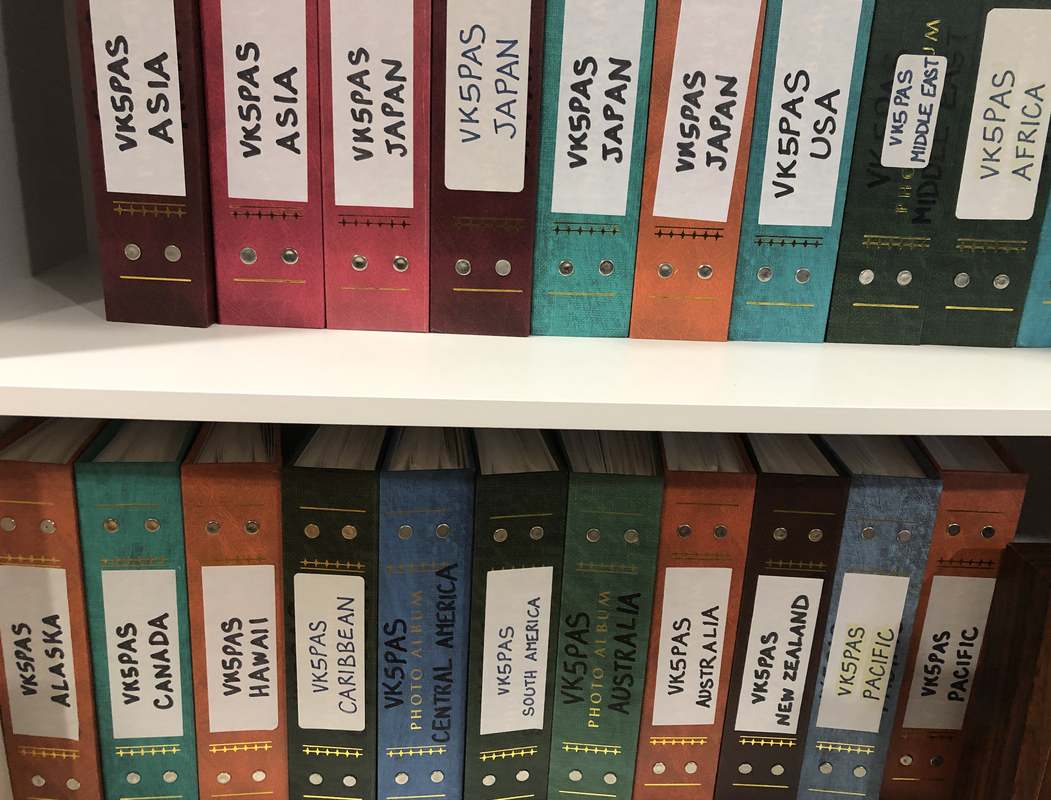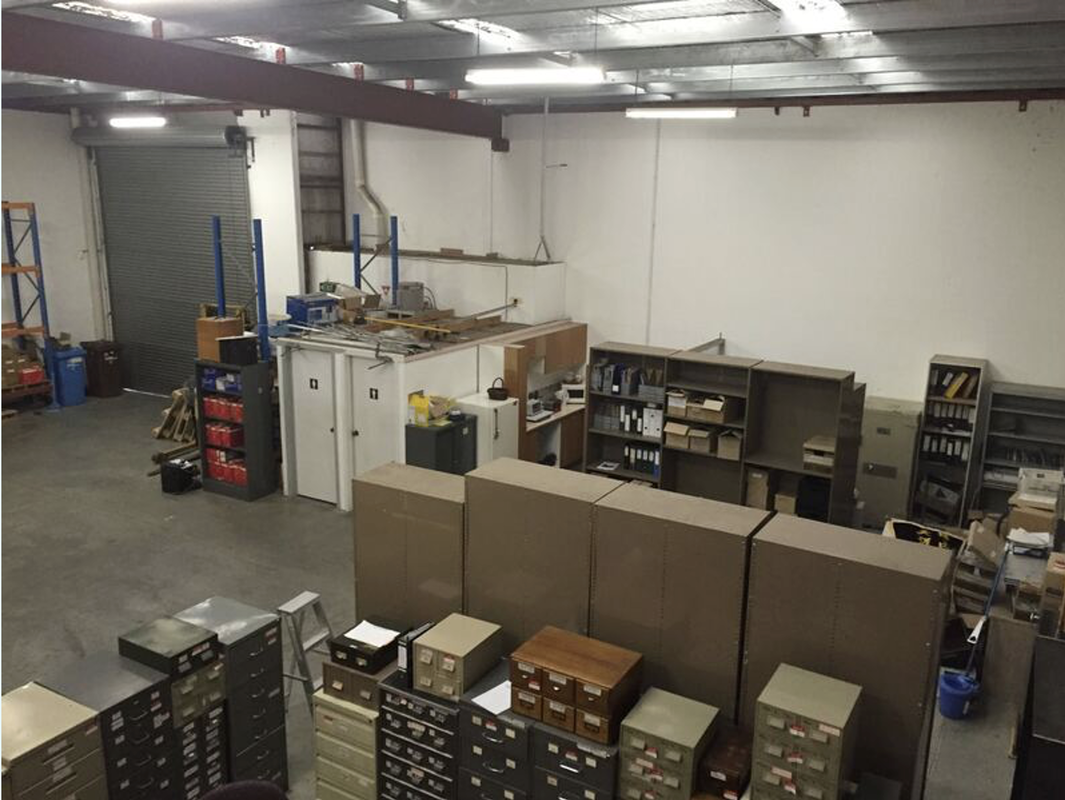COLLECTING QSL CARDS
WHAT IS A QSL CARD?
A QSL card is a documented confirmation of a contact with another amateur radio station.
QSL cards are also used by....
QSL cards are also used by....
- CB radio operators
- short Wave Listeners (SWL)
- broadcast stations
Sending and receiving QSL cards is a traditional part of the hobby of amateur radio. It dates back to the early years of the hobby. Sending a QSL card is often referred to as the 'final courtesy of a QSO'.
QSL cards are often referred to by amateur radio oeprators as 'wallpaper'.
QSL cards are often referred to by amateur radio oeprators as 'wallpaper'.
WHAT DOES QSL MEAN?
The term QSL is adopted from the Q code, a standardised collection of 3 letter codes that each start with Q. They were initially designed for commercial radiotelegraph communication, and were later adopted by amateur radio.
The Q codes were created c. 1909 by the British Government, prepared for the use of British ships and coast stations licenced by the Postmaster General.
Q. Can you acknowledge receipt?
A. Yes I am acknowledging receipt.
Therefore a QSL card is an acknowledgement card.
The Q codes were created c. 1909 by the British Government, prepared for the use of British ships and coast stations licenced by the Postmaster General.
Q. Can you acknowledge receipt?
A. Yes I am acknowledging receipt.
Therefore a QSL card is an acknowledgement card.
HISTORY OF QSL CARDS.
In June 1916 a letter appeared in QST magazine from Edward Andrews 3TW os Philadelphia, Pennsylvania. He spoke about a card he had received from William T. Fraser 8VX of Buffalo, New York.
This is the first known mention of a 'QSL card'.
Mr. Andrews made the following comments.....
This is the first known mention of a 'QSL card'.
Mr. Andrews made the following comments.....
“I wish to commend the spirit of unselfishness that is quite evident in Mr. Fraser and others who send cards which tell of receiving the signals of a fellow amateur.”
“I would urge upon the members of the A.R.R.L. and the readers of QST to notify by postal and by the very next mail the owner of the station whose signals they hear and to give such other information as they may think of aid or inspiration to the recipient”.
The Editor of QST magazine responded with the following comments.....
In August 1919, another letter appeared in QST magazine. This time it was from Carl D. (Don) Hoffman 8UX. Hoffman was the cartoonist with QST magazine.
Hoffman wrote the following.....
Hoffman wrote the following.....
“Here’s a little idea-run a suggestion that the fellows with long distance ham receiving sets make themselves up a form for post cards something like this and send each time a new long distance station is heard.”
Hoffman was accredited the inventor of the 'amateur DX report card' by QST magazine.
The first ever QSL card in Europe was produced by William Edward 'Bill' 'Uncle Vic' Corsham 2UV.
In the September 1924 edition of QST magazine, an article appeared from Howard S. Pyle 8ST, entitiled 'The Amateur DX Report Card. A study of the International Fad That 8UX Started'.
Pyle was critical of various aspects of QSL cards and made a number of comments including the following.....
Pyle was critical of various aspects of QSL cards and made a number of comments including the following.....
- "the majority of amateur DX report cards have many faults.”’
- “why plaster the station walls with report cards? It does not appear to be a really good stunt.”
- “avoid cheapening your card by a display of ‘vaudeville humor.’”
- “take a little time and see if you can’t evolve a DX card that will be a credit to your station”
In 1927 at the International Radiotelegraph Convention in Washington, the Radiotelegraph Regulations 1927 were passed. This included the assigning of callsigns to each country, e.g.
VHA-VMZ Australia
K, N, W USA
G Great Britain
VHA-VMZ Australia
K, N, W USA
G Great Britain
WHY QSL?
- thrill of receiving a QSL in the mail
- awards
- tradition
- hobby within a hobby
- create memories.
DO I HAVE TO SEND A QSL CARD?
It is not compulsory to send a QSL card to confirm a contact.
It is considered environmentally wasteful to send a QSL card for each contact made with the same station.
It is considered environmentally wasteful to send a QSL card for each contact made with the same station.
TYPES OF QSL CARDS.
- hard copies
- Direct or via the Bureau
- eQSL
- Logbook Of The World (LOTW)
- Electronic
CHOOSING A QSL CARD.
- design your own and have a local printer produce them
- QSL creators - web
- order from one of the many large QSL card printing companies
- Give consideration to the layout of the card
- photos, logos
- Consider the quantity you will need
- Larger quantities are generally less expensive
STANDARD SIZE OF A QSL CARD.
IARU & member societies recommend a maximum size of 3½ by 5½ inches (140 mm by 90 mm).
Cards of unusual dimensions slow the work of Bureaus.
Some cards (especially from DXpeditions) can be a gate-fold design with multiple pages.
Cards of unusual dimensions slow the work of Bureaus.
Some cards (especially from DXpeditions) can be a gate-fold design with multiple pages.
WHAT DOES A QSL CARD CONTAIN?
- amateur radio station callsign
- location
- licensee’s name
- postal address
- details on radio equipment
- date/time of contact
- frequency/mode
- signal report
- Comments
- IOTA reference & Island name
- CQ zone/ITU zone
WHAT SHOULD THE CARD NOT CONTAIN?
- religious statements
- political statements
- what seems humorous to you, may not be to somebody in a foreign country
- what may not be offensive to you, may be to someone in a foreign country
SOME BASICS WHEN FILLING OUT A CARD.
- ALWAYS use UTC time – NEVER local time
- ensure your shack clock is accurate use legible writing
- use printed labels if your handwriting is poor
- ensure the details on the card are accurate
- do not cross out mistakes – start again
- signal reports using the RST system
- multiple QSOs – list in chronological order
OTHER TIPS.
- be patient
- QSL Bureau takes considerable time
- Direct QSLs don’t come back overnight
- QSL Bureau takes considerable time
- listen to any QSL instructions given by the station on air
- ensure the DX station has your callsign correct
- ensure you have the DX stations callsign correct
- copying errors from the DX Cluster and not listening
PHYSICALLY SENDING OUT QSL CARDS.
- Bureau
- Direct
- QSL Manager
QSL BUREAUS.
Many of the National bodies representing amateur radio operators, e.g. WIA, ARRL, RSGB, offer a QSL Bureau system for their members. They are a specialised 'post office' for QSL cards.
The QSL Bureau is the least expensive way of sending QSL cards.
The QSL Bureau is the least expensive way of sending QSL cards.
QSL Bureaus developed due to the following reasons......
- addresses of individual stations not being widely available
- international postage was expensive
- following WWII – difficult to obtain addresses for amateurs in Soviet Union and most other Warsaw Pact countries
- callbooks were incomplete for many countries
In Australia, incoming QSL cards for VK amateurs are received at the National Incoming QSL Bureau. They are then distributed to the relevant Australian State and Territory Bureau, where they are then sorted and distributed to the recipient of the QSL card.
Incoming QSL cards are distributed to the State and Territory Bureaus at least every 3 months.
Incoming QSL cards are distributed to the State and Territory Bureaus at least every 3 months.
PREFERRED PREFIX.
When sending QSL cards to the QSL Bureau, cards must be sorted and grouped together.
QSL cards need to be addressed correctly by designating the preferred prefix of the destination Bureau. Only the preferred prefix of the destination Bureau must be printed in the top right hand corner on the front or back of the card.
Below you can view a copy of the Preferred Prefix listing.....
QSL cards need to be addressed correctly by designating the preferred prefix of the destination Bureau. Only the preferred prefix of the destination Bureau must be printed in the top right hand corner on the front or back of the card.
Below you can view a copy of the Preferred Prefix listing.....
| wia_qsl_card_buro_preferred_prefix.pdf | |
| File Size: | 12 kb |
| File Type: | |
SENDING A CARD DIRECT.
This is the most expensive way of sending a card. You will be paying postage both ways. The advantage is that the return of your card will normally be quick.
Direct QSLs are sent to the station worked or via their QSL Manager.
Direct QSLs are sent to the station worked or via their QSL Manager.
TIPS WHEN SENDING DIRECT.
- follow the instructions on QRZ.com
- Send to the correct address
- if they have a QSL Manager, then the card goes there
- if they have a QSL Manager, then the card goes there
- include a self address envelope
- Use heay duty envelopes – not flimsy
- include return postage – USD or IRC
- Don’t let the $$ or IRC be visible
- Postal theft
- Don’t write callsigns on envelope
- Seal the envelope with sticky tape to prevent tampering
- Don’t use commemorative stamps
- Make the letter look like a professional letter, not a personal letter
- cut a small corner so the contents of the envelope can be inspected
WHAT DOES PSE & TNX MEAN?
Pse - Please QSL
Tnx - Thanks
Tnx - Thanks
READ THE INSTRUCTIONS.
Take the time to read carefully any QSL instructions on either the station's QRZ.com page or website.
IF YOU SAY THAT YOU QSL, THEN PLEASE QSL!
I have sent NUMEROUS QSL card requests to VK amateurs over the years, who say they QSL Direct on their QRZ.com page, and I have never received a reply.
Please, if you say that you QSL, then please do the courtesy of returning a QSL card.
If you don't QSL, then please modify your QRZ.com page to indicate that you do not QSL.
Please, if you say that you QSL, then please do the courtesy of returning a QSL card.
If you don't QSL, then please modify your QRZ.com page to indicate that you do not QSL.
QSL MANAGERS.
QSL Managers manage QSL operations on behalf of other amateurs, particularly DXpeditions.
Reasons......
Reasons......
- no bureau exists for that country
- operation is only short lived e.g. DXpedition
- postal services may be poor
- maximise operating time
OQRS - ONLINE QSL REQUESTS.
The OQRS system enables amateurs to request a QSL card through the log search page in Club Log.
There is an option to have card sent direct (payment) or via the bureau.
This is available to all Club Log users. Clublog is a free web-based tool for producing DXCC league tables, expedition tools, log search services & most wanted lists.
The OQRS system is a quicker option, and there is no need to send your QSL card
There is an option to have card sent direct (payment) or via the bureau.
This is available to all Club Log users. Clublog is a free web-based tool for producing DXCC league tables, expedition tools, log search services & most wanted lists.
The OQRS system is a quicker option, and there is no need to send your QSL card
eQSL.
- designed to be the fastest, easiest, and cheapest way to exchange QSO confirmations
- Fast upload
- apply for awards online
- can print out the card
LOGBOOK OF THE WORLD (LOTW)
- Fast upload
- No physical cards or electronic card
- Receive a credit – towards DXCC & other awards
- Fees charged
ELECTRONIC QSL - EMAIL.
Due to costs, there has been an increase in electronic QSLing - via email.
WHAT TO DO WITH ALL OF YOUR QSL CARDS.
UPON YOUR PASSING.
Consider passing on your collection to one of the historical QSL card collections.
The WIA has a Historical QSL card collection.
The WIA has a Historical QSL card collection.
Above:- Part of the QSL collection at the WIA, Melbourne. Image c/o VK5PAS.
ARTICLES AND PRESENTATIONS.
'How to succed at QSLing without really trying' by Ron WN3VAW.
| howtosucceedatqsling.pdf | |
| File Size: | 114 kb |
| File Type: | |
Logbook of the World (LOTW).
| lotw_presentation.ppt | |
| File Size: | 54001 kb |
| File Type: | ppt |
GROUPS.IO SITES.
QSL card collectors Groups.io site.
YOU TUBE VIDEOS.
References.
- Amateur Radio Victoria, 2020, <https://www.amateurradio.com.au/qslcards>, viewed 11th March 2020.
- ARRL
- Clublog, 2023, <clublog.org/>, viewed 18th July 2023
- How to Succees at QSLing by WN3VAW
- M0OXO
- M0URX
- W5UE, 2023, <w5ue.net>
- Wikipedia, 2020, <https://en.wikipedia.org/wiki/QSL_card>, viewed 11th March 2020.
- Wireless Institute of Australia, 2023, <>www.wia.org.au/members/qsl/about/, viewed 20th May 2023.
